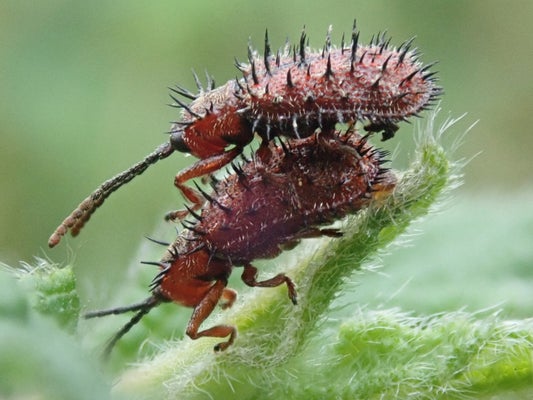
Quick facts
Common name - Rockrose prickly leaf beetle
Scientific name - Dicladispa testacea
Plants affected - Cistus
Main symptoms - Larval blotch mines in foliage, beetles on leaves
Most active - Spring to Autumn
What is Rockrose prickly leaf beetle?
Rockrose prickly leaf beetle belongs to the leaf beetle family Chrysomelidae of which there are about 250 species found in Britain. Leaf beetles all feed on plants although most do not have a noticeable effect on garden plants. These beetles can be colourful and many species are local or rare.
Rockrose prickly leaf beetle is a 5 mm long, brownish-red, leaf beetle with black spines. It feeds on plants in the rockrose family Cistaceae, especially the genus Cistus. The spines give it an appearance unlike any other beetle found in Britain.
Rockrose prickly leaf beetle belongs to the tribe Hispini, which is the second most species-rich tribe, within the tortoise-beetle subfamily Cassidinae of the Chrysomelidae. This beetle is the only species of Hispini so far reported from Britain and the only species of Hispini that feeds on Cistus.
The genus Dicladispa includes 125 species, which occur mostly in the tropics and subtropics, with a few species in the warm parts of the Palaearctic. In Europe Dicladispa testacea is the most widely distributed species belonging to this genus; here it has a generally coastal maritime distribution.

Symptoms
The adult beetles feed on the leaves and the larvae feed within leaf mines of Cistus. They can be present from spring to autumn. Affected leaves have pale blotch leaf mines. It appears that this does not affect the overall health of the plant.
The beetle was found breeding in Britain for the first time in August 2021, from a garden in West London. An additional site, also in London, was found in September 2021. It seems likely that rockrose prickly leaf beetle will establish and spread in Britain, in areas where Cistus is planted.
Do I need to manage Rockrose prickly leaf beetle?
Although there is some uncertainty, rockrose prickly leaf beetle can be tolerated and accepted as a part of garden . The beetle does not appear to cause significant damage to Cistus in the countries where it is already present.
If you find this distinctive beetle in your garden, please send an image with location details to the following email address: [email protected]
Biology
The female beetle makes a small hole on the underside of a Cistus leaf in which to deposit an egg. This is then covered with insect excrement (frass). Each larva develops in a leaf mine of a broad and irregular shape with a darker central part due to larval excrement. When mature the 4 mm long larva leaves its mine to build a new one. This second mine is an elongate channel shape situated along the leaf midrib; it is here the larva pupates.
The adult beetle starts to feed 12 to 24 hours after emergence from the pupa whilst its yellowish-brown body, with black spines, darkens and becomes harder.




